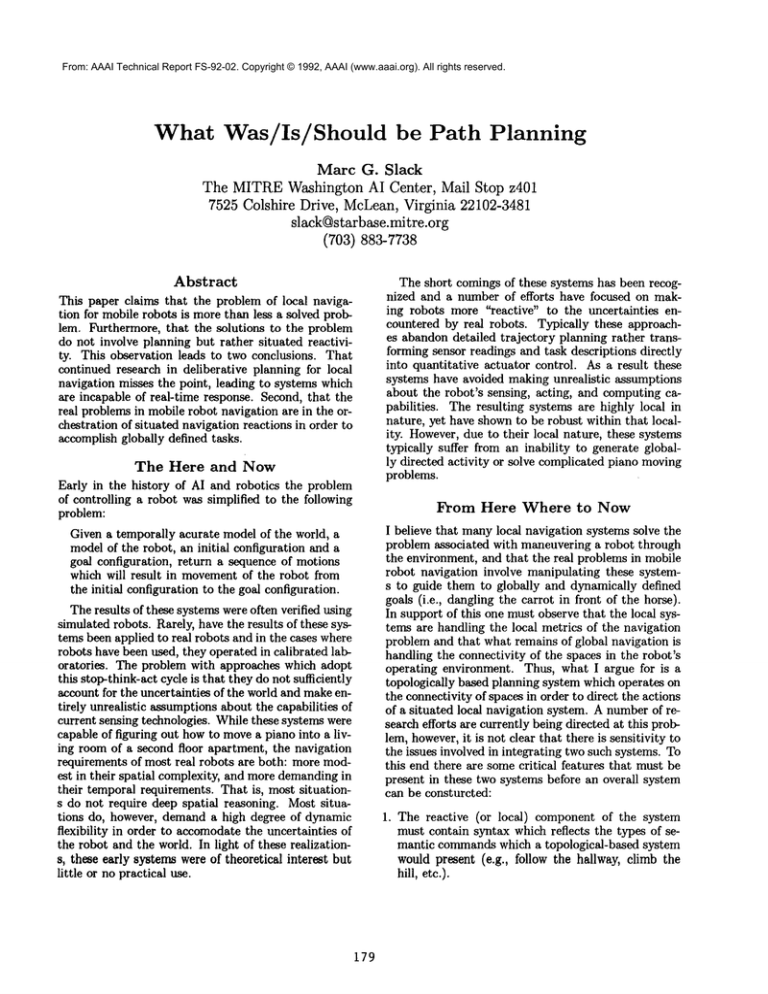
From: AAAI Technical Report FS-92-02. Copyright © 1992, AAAI (www.aaai.org). All rights reserved.
What Was/Is/Should
be Path Planning
Marc G. Slack
The MITREWashington AI Center, Mail Stop z401
7525 Colshire Drive, McLean,Virginia 22102-3481
slack~starbase.mitre.org
(703) 883- 7738
Abstract
This paper claims that the problem of local navigation for mobile robots is more than less a solved problem. Furthermore, that the solutions to the problem
do not involve planning but rather situated reactivity. This observation leads to two conclusions. That
continued research in deliberative planning for local
navigation misses the point, leading to systems which
are incapable of real-time response. Second, that the
real problems in mobile robot navigation are in the orchestration of situated navigation reactions in order to
accomplish globally defined tasks.
The Here and Now
Early in the history of AI and robotics the problem
of controlling a robot was simplified to the following
problem:
The short comings of these systems has been recognized and a number of efforts have focused on making robots more "reactive" to the uncertainties encountered by real robots. Typically these approaches abandon detailed trajectory planning rather transforming sensor readings and task descriptions directly
into quantitative actuator control. As a result these
systems have avoided making unrealistic assumptions
about the robot’s sensing, acting, and computing capabilities. The resulting systems are highly local in
nature, yet have shownto be robust within that locality. However, due to their local nature, these systems
typically suffer from an inability to generate globally directed activity or solve complicated piano moving
problems.
From Here
Given a temporally acurate model of the world, a
model of the robot, an initial configuration and a
goal configuration, return a sequence of motions
which will result in movementof the robot from
the initial configuration to the goal configuration.
The results of these systems were often verified using
simulated robots. Rarely, have the results of these systems been applied to real robots and in the cases where
robots have been used, they operated in calibrated laboratories. The problem with approaches which adopt
this stop-think-act cycle is that they do not sufficiently
account for the uncertainties of the world and makeentirely unrealistic assumptions about the capabilities of
current sensing technologies. While these systems were
capable of figuring out how to movea piano into a living room of a second floor apartment, the navigation
requirements of most real robots are both: more modest in their spatial complexity, and more demandingin
their temporal requirements. That is, most situations do not require deep spatial reasoning. Most situations do, however, demand a high degree of dynamic
flexibility in order to accomodatethe uncertainties of
the robot and the world. In light of these realizations, these early systems were of theoretical interest but
little or no practical use.
179
Where to Now
I believe that manylocal navigation systems solve the
problem associated with maneuvering a robot through
the environment, and that the real problems in mobile
robot navigation involve manipulating these systems to guide them to globally and dynamically defined
goals (i.e., dangling the carrot in front of the horse).
In support of this one must observe that the local systems are handling the local metrics of the navigation
problem and that what remains of global navigation is
handling the connectivity of the spaces in the robot’s
operating environment. Thus, what I argue for is a
topologically based planning system which operates on
the connectivity of spaces in order to direct the actions
of a situated local navigation system. A number of research efforts are currently being directed at this problem, however,it is not clear that there is sensitivity to
the issues involved in integrating two such systems. To
this end there are some critical features that must be
present in these two systems before an overall system
can be consturcted:
1. The reactive (or local) component of the system
must contain syntax which reflects the types of semantic commandswhich a topological-based system
would present (e.g., follow the hallway, climb the
hill, etc.).
From: AAAI Technical Report FS-92-02. Copyright © 1992, AAAI (www.aaai.org). All rights reserved.
2. The reactive system must be cognizant of it’s inability to accomplish a given local task. This is important because, it is the reactive component which is
handling the robot metric interaction with the world
(thus the location of the information necessary for
making such assessments).
3. The topological system must be realistic about the
types of models which can be attained using the sensors mounted on the robot. While a priori maps
are useful in manycases they miss the point as the
sensing and modeling capabilities of real-robots are
insufficient to match perceptions to locations in the
given map.
4. That the topological system be sensitive to the operational range as well as failures of the reactive system. This is critical when operating in real-spaces
as uncertainty may make a previously used plan inappropriate for the current state of the world.
5. Finally, methods must be developed and explored
for verifying the robustness of the system. Focusing
on the domain of a real problem, tests should be
performed to measure the robustness of the system
operating in that domain.
It is my hope that the area of mobile robot navigation will soon be mature. This will allow persons
focusing on larger mobile robot problems, to assume
an autonomous capability for maneuvering through the
world as defined by their problem domain.
180



